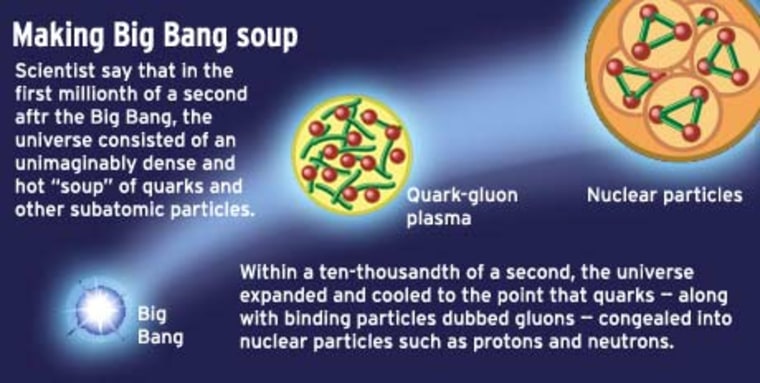What do you get when you turn the temperature up to a trillion degrees?
Quite a heating bill.
Actually physicists claim that at this temperature nuclear material melts into an exotic form of matter called a quark-gluon plasma — thought to have been the state of the universe a microsecond after the Big Bang.
Re-creating this primordial soup is the primary purpose of the Relativistic Heavy-Ion Collider at Brookhaven National Laboratory. After five years of data, it appears as if RHIC (pronounced like "Rick") may have succeeded.
But a big mystery looms over the detection: The putative plasma explodes more violently than predicted.
"We expected to bring the nuclear liquid to a boil and produce a steam of quark-gluon plasma," said John Cramer from the University of Washington. "Instead, the boiler seems to be blowing up in our faces."
The explosive result, which goes by the name of the HBT puzzle, may call into question what RHIC is making in its high-speed collisions, or it might mean the theory needs retuning.
Cramer and his colleagues have another alternative explanation, too: Perhaps the explosion is not as explosive as the data suggests. The scientists use 50-year-old physics to reinterpret the measurements at RHIC.
"We have taken a quantum mechanics technique, called the nuclear optical model, from an old and dusty shelf and applied it to puzzling new physics results," said Gerald Miller, a co-author also at the University of Washington. "It's really a scientific detective story."
Collecting clues
The main suspect in this detective story is the quark-gluon plasma. But how do you know when you’ve seen it? The plasma cannot be observed directly — it disappears in less than a hundredth of a billionth of a trillionth of a second. All that researchers can hope to do is detect the particles that fly out when the plasma freezes back into normal matter.
"You can’t go in there and directly measure the quarks and gluons," Miller told Space.com. "You have to work back from what you measure to what you believe was there."

Scott Platt from Michigan State University, who didn't participate in the new research, compares detecting the quark-gluon plasma to what astronomers have to do when studying an exploding star.
"They only see the light coming from the star’s surface and then try to infer what happened inside. We [physicists] have the same problem," he said.
Instead of light, RHIC researchers see thousands of particles — mostly pions, which are tiny things weighing about one-seventh as much as a proton, itself subatomic. The pions show up in detectors set up around collision points, where gold nuclei traveling at 99.995 percent of the speed of light hit each other head-on.
To see a movie of a gold-on-gold collision click here (note that the gold nuclei look like pancakes because they are traveling so fast).
"We can’t stick a barometer or thermometer into the collision center," Platt explained, but by a careful reconstruction of the flight paths of all the debris coming out, scientists can extract information about the brief, but intense, furnace created when gold nuclei smash into each other.
From the RHIC data, research teams have identified three smoking guns for the quark-gluon plasma:
- The collision center is under high pressure.
- The collision center behaves a lot like a fluid.
- Very high energy particles do not escape.
Did they or didn't they?
Although this evidence appears solid, physicists are hesitant to say they have created the melted nuclear goop. "That debate is going on as we speak," Platt said.
One of the reasons for this conservative approach has to do with how fast the supposed plasma appears to freeze back into ordinary matter. Theory assumed this phase transition would take almost twice as long as was measured.
"In science, if you have a bunch of things that are right, it won’t matter if one thing goes wrong," Miller said.
The apparent explosion of pions and other particles coming from the phase transition is the so-called HBT puzzle.
"It is the one RHIC observation that deserves the word 'puzzle' or 'surprise,'" Platt said.
HBT puzzle
To measure the duration of the plasma’s phase transition, physicists use an astronomy tool, called Hanbury Brown-Twiss interferometry. The HBT technique, named after researchers Robert Hanbury Brown and Richard Twiss, can find the diameter of stars using the radio signals from two separate telescopes.
Instead of comparing radio waves, physicists compare two pions flying out from the collision center. But these measurements require a lot of modeling and approximations, Platt explained.

Cramer and Miller and their collaborators have redone the calculations, incorporating something called the nuclear optical model. This dates back to 1950s, when scientists were beginning to understand the strong interactions inside the nucleus.
Effectively, this old-school physics accounts for the fact that, as pions form out of the cooling plasma, they will have to climb their way out of an attractive field — similar to the gravitational field that a rocket has to overcome to escape a planet’s clutches.
"This is not surprising, since it has already been shown that the medium is very dense," Miller said. "It is as if the pions are trying to leave a crowded room."
According to Cramer, this crowded room "distorts" the data, making the transition look more explosive than it really is. In a sense, the HBT puzzle could be a simple misinterpretation of what the data shows.
Is the puzzle really solved?
Platt is unsure that Cramer and Miller’s work, published this month in Physical Review Letters, indeed clears up the HBT puzzle entirely.
"They pointed out one of the ways that the calculations can be improved," he said. "But the analysis is ongoing."
If the puzzle does end up being solved, will physicists be ready to claim victory?
"It is not for me to say that we have found the quark-gluon plasma," Cramer said. "But we have made an important step."
